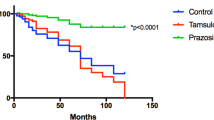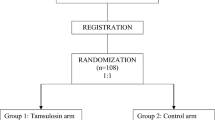Abstract
Objective
This study was done to assess the impact of clinical factors and in particular the use of drugs for concomitant illnesses on late radiation-induced rectal bleeding in patients with prostate cancer.
Materials and methods
Patients with histologically proven prostate adenocarcinoma treated with radical radiotherapy and followed up for at least 6 months were selected. The correlation between late rectal bleeding and a number of factors was investigated by univariate and multivariate analysis.
Results
A total of 278 patients who underwent radiotherapy at our institution between October 2002 and May 2011 were selected. At univariate analysis, delivery of radiation doses higher than 70 Gy and use of angiotensin-converting enzyme inhibitors were associated with a higher incidence of rectal bleeding. Conversely, patients who used calcium channel blockers had a lower risk (3-year rectal bleeding-free survival 89.8 versus 66.5 %, p = 0.043). At multivariate analysis, use of calcium channel blockers was found to have a protective effect with a hazard ratio of 0.3 (95 % CI 0.12–0.96). Delivery of higher radiation doses was associated with an increased risk of rectal bleeding (hazard ratio 3.02, 95 % CI 1.23–7.38).
Conclusions
Use of calcium channel blockers during and after radiotherapy treatment might have a protective effect against late rectal bleeding. If these results are reconfirmed by larger clinical series, calcium channel blockers may be tested as radioprotector agents in clinical trials.
Similar content being viewed by others
References
American Cancer Society (2011) Cancer facts and figures 2011. American Cancer Society, Atlanta
NCCN clinical practice guidelines in oncology. Prostate cancer. Version 4.2011. Available on-line at http://www.nccn.org/professionals/physician_gls/pdf/prostate.pdf
Halverson S, Schipper M, Blas K et al (2011) The cancer of the prostate risk assessment (CAPRA) in patients treated with external beam radiation therapy: evaluation and optimization in patients at higher risk of relapse. Radiother Oncol 101:513–520
Syndikus I, Morgan RC, Sydes MR et al (2010) Late gastrointestinal toxicity after dose-escalated conformalradiotherapy for early prostate cancer: results from the UK Medical Research Council RT01 trial (ISRCTN47772397). Int J Radiat Oncol Biol Phys 77:773–783
Söhn M, Yan D, Liang J et al (2007) Incidence of late rectal bleeding in high-dose conformal radiotherapy of prostate cancer using equivalent uniform dose-based and dose-volume-based normal tissue complication probability models. Int J Radiat Oncol Biol Phys 26:1066–1073
Tucker SL, Dong L, Bosch WR et al (2010) Late rectal toxicity on RTOG 94-06: analysis using a mixture Lyman model. Int J Radiat Oncol Biol Phys 78:1253–1260
Al-Mamgani A, Heemsbergen WD, Peeters ST, Lebesque JV (2009) Role of intensity-modulated radiotherapy in reducing toxicity in dose escalation for localized prostate cancer. Int J Radiat Oncol Biol Phys 73:685–691
Valdagni R, Kattan MW, Rancati T et al (2012) Is it time to tailor the prediction of radio-induced toxicity in prostate cancer patients? Building the first set of nomograms for late rectal syndrome. Int J Radiat Oncol Biol Phys 82:1957–1966
Barnett GC, De Meerleer G, Gulliford SL et al (2011) The impact of clinical factors on the development of late radiation toxicity: results from the Medical Research Council RT01 trial (ISRCTN47772397). Clin Oncol (R Coll Radiol) 23:613–624
Deodato F, Cilla S, Massaccesi M et al (2012) Daily on-line set-up correction in 3D-conformal radiotherapy: is it feasible? Tumori 98:441–444
Cox JD, Stetz J, Pajak TF (1995) Toxicity criteria of the Radiation Therapy Oncology Group (RTOG) and the European Organization for Research and Treatment of Cancer (EORTC). Int J Radiat Oncol Biol Phys 31:1341–1346
Jahraus CD, Bettenhausen D, Malik U et al (2005) Prevention of acute radiation-induced proctosigmoiditis by balsalazide: a randomized, double-blind, placebo controlled trial in prostate cancer patients. Int J Radiat Oncol Biol Phys 63:1483–1487
Khan AM, Birk JW, Anderson JC et al (2000) A prospective randomized placebo-controlled double-blinded pilot study of misoprostol rectal suppositories in the prevention of acute and chronic radiation proctitis symptoms in prostate cancer patients. Am J Gastroenterol 95:1961–1966
Kligerman MM, Liu T, Liu Y et al (1992) Interim analysis of a randomized trial of radiation therapy of rectal cancer with/without WR-2721. Int J Radiat Oncol Biol Phys 22:799–802
Martenson JA, Bollinger JW, Sloan JA et al (2000) Sucralfate in the prevention of treatment-induced diarrhea in patients receiving pelvic radiation therapy: a North Central Cancer Treatment Group phase III double-blind placebo-controlled trial. J Clin Oncol 18:1239–1245
Battaini F, Govoni S, Trabucchi M, Paoletti R (1988) Calcium antagonism tissue protection. Pharmacol Ther 39:385–388
Weglicki WB, Mak IT, Dickens BF, Kramer JH (1992) Beta blockers, calcium channel blockers and the sulfhydryl-ACE inhibitors demonstrate protection against free-radical mediated injury of cardiovascular cells and membranes. Rev Port Cardiol 11:1009–1011
Potten CS (1977) Extreme sensitivity of some intestinal crypt cells to X and gamma irradiation. Nature 269:518–521
Potten CS (2004) Radiation, the ideal cytotoxic agent for studying the cell biology of tissues such as the small intestine. Radiat Res 161:123–136
Paris F, Fuks Z, Kang A et al (2001) Endothelial apoptosis as the primary lesion initiating intestinal radiation damage in mice. Science 293:293–297
Sugiura T, Kondo T, Kureishi-Bando Y et al (2008) Nifedipine improves endothelial function: role of endothelial progenitor cells. Hypertension 52:491–498
Matsubara M, Yao K, Hasegawa K (2006) Benidipine, a dihydropyridine-calcium channel blocker, inhibits lysophosphatidylcholine-induced endothelial injury via stimulation of nitric oxide release. Pharmacol Res 53:35–43
Eisenberg MJ, Brox A, Bestawros AN (2004) Calcium channel blockers: an update. Am J Med 116:35–43
Weiner DA (1988) Calcium channel blockers. Med Clin N Am 72:83–115
Bauman G, Rumble RB, Chen J, Loblaw A, Warde P, Members of the IMRT Indications Expert Panel (2012) Intensity-modulated radiotherapy in the treatment of prostate cancer. Clin Oncol (R Coll Radiol) 24(7):461–473
Sullivan R, Peppercorn J, Sikora K et al (2011) Delivering affordable cancer care in high-income countries. Lancet Oncol 12:933–980
Acknowledgments
The authors thank Milly Buwenge for her contribution in revising the English language of this manuscript.
Conflict of interest
Mariangela Massaccesi, Edy Ippolito, Francesco Deodato, Savino Cilla, Cinzia Digesù, Gabriella Macchia, Luciana Caravatta, Vincenzo Picardi, Gian Carlo Mattiucci, Alessandra Di Lallo, Daniele Cuscunà, Numa Cellini, Vincenzo Valentin, Alessio G. Morganti declare no conflict of interest.
Author information
Authors and Affiliations
Corresponding author
Rights and permissions
About this article
Cite this article
Massaccesi, M., Ippolito, E., Deodato, F. et al. Radioprotective effect of calcium channel blockers against late rectal bleeding in prostate cancer. Radiol med 119, 343–347 (2014). https://doi.org/10.1007/s11547-013-0346-z
Received:
Accepted:
Published:
Issue Date:
DOI: https://doi.org/10.1007/s11547-013-0346-z




